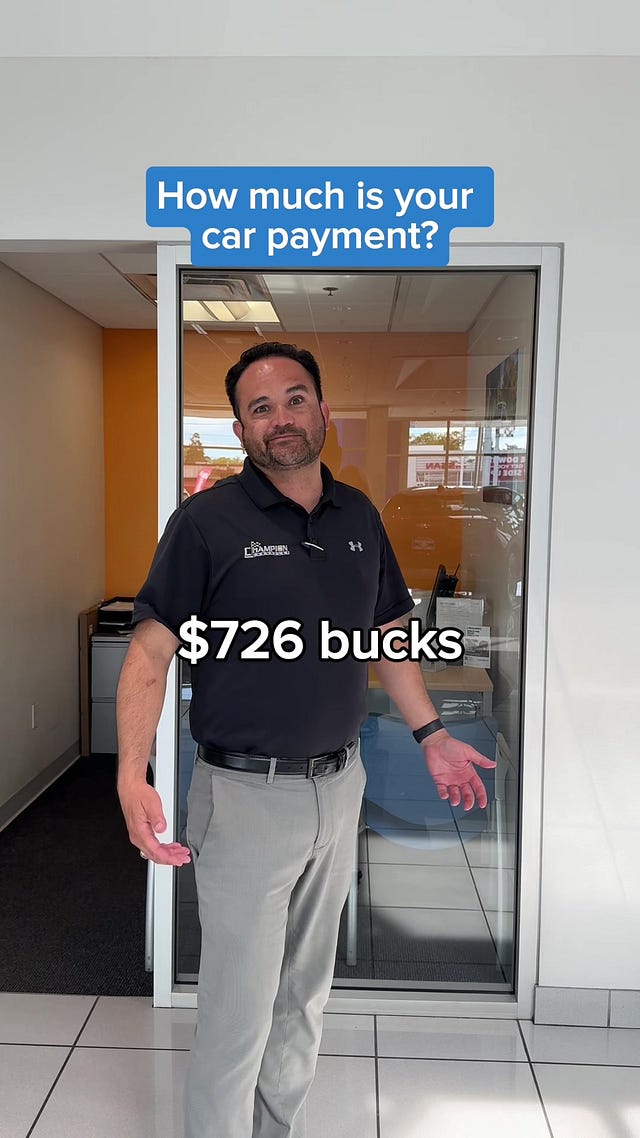“How Much Is Your Car Payment?” — What a TikTok Trend Tells Us About Our Money Habits
Car Payments Are Getting Wild—Let’s Talk About It
Spotted on TikTok: This video from Champion Chevrolet Reno asking people what they pay for their cars—and some of the answers might surprise you.
In this viral TikTok from Champion Chevrolet Reno, a car salesman stops people and hits them with one question: 'How much is your car payment?'
That’s it. No fluff, no setup. Just people being put on the spot about how much they pay every month for their car. The answers range from what you might expect to, frankly, what made us do a double-take. Some people are paying around $300 to $400. Others? $700, $800, even over $1,000.
And judging by the comments and stitches this video has sparked, we’re clearly not the only ones who were shocked.
But here's the thing: this trend taps into something we don't often talk about openly—how personal our money choices are, and how easy it is to normalize debt when it's packaged as monthly payments, especially when everyone around you is doing the same.
Why Car Payments Feel “Normal”
Monthly payments have made big purchases digestible. You’re not buying a $42,000 SUV—you’re “only” paying $725 a month for it. Throw in low (or zero) down payments and long loan terms, and suddenly, it feels affordable until your budget starts suffocating.
This is exactly why TikTok videos like this one go viral. They give us this fascinating peek into how people are living—not just what they bought, but how they’re paying for it. And often, how much financial strain they're quietly carrying.
It’s worth pointing out: we’re not seeing the full picture in these short clips. We don’t know anyone’s income, savings, or financial goals. But it raises a valuable question for the rest of us: how much car is too much car?
What We Don’t See in the TikTok Videos
What TikTok doesn’t show is how someone came to that monthly number. Most car payments result from a few key things: the price of the car, how much (if anything) was put down, the loan term, and the interest rate.
A $750 car payment might mean a $50,000 car over 72 months. Or it could mean a mid-range car at a terrible interest rate. There are a dozen ways to get to that number, but not all of them are good for your finances.
Longer loan terms (six, seven, even eight years) have become common because they bring down the monthly payment—but they also mean you’re paying more in interest, and you’re stuck with the loan much longer. It’s the financial version of kicking the can down the road.
So What’s the Right Amount?
There’s a common guideline in personal finance called the 20/4/10 rule. It suggests putting down 20%, financing the car over no more than four years, and keeping your total car expenses (not just the payment, but insurance and gas too) under 10% of your gross income.
That sounds great in theory, but in practice? Most people don’t follow it. And to be honest, in today’s car market, it might not even feel realistic for everyone. So instead of treating that rule as gospel, it can just be a gut check. If you’re paying $900 a month and can’t save, invest, or breathe without stressing every paycheck, maybe it’s time to rethink what “affordable” really means.
Takeaways for Your Financial Journey
Assess Affordability: Before committing to a car purchase, evaluate your budget to determine what you can comfortably afford without compromising other financial goals.
Research Financing Options: Shop around for the best interest rates and loan terms. Credit unions, banks, and dealership financing each have pros and cons.
Consider Total Ownership Costs: Factor in insurance, maintenance, fuel, and registration fees when calculating the true cost of car ownership.
Avoid Impulse Decisions: Viral trends and peer comparisons can influence spending. Make choices based on your financial situation and long-term objectives.
Trends like this are popular because they make personal finance feel relatable. They show real people making real choices. But they're also a great reminder that we need to be more intentional about how those choices affect our bigger financial picture.
So next time you see a video like this, don’t just think, “Wow, that’s a lot for a car.” Think: “Is my car payment actually working for me—or am I working for my car?”
And if you're not sure? That's okay. These conversations are the first step toward figuring it out.
Disclaimer: The information provided is not intended to replace professional financial advice tailored to your unique situation. Despite our best efforts to ensure the accuracy and timeliness of the information presented here, we make no express or implied representations or warranties about its completeness, accuracy, reliability, suitability, or availability. Any reliance you place on such information is solely at your own risk. Please be advised that the content herein is not financial advice. It is highly recommended that you seek personalized financial advice from a professional.





